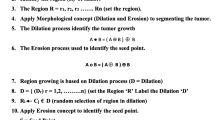Abstract
The purpose of this paper is to present the variational method for geometric contours which helps the level set function remain close to the sign distance function, therefor it remove the need of expensive re-initialization procedure and thus, level set method is applied on magnetic resonance images (MRI) to track the irregularities in them as medical imaging plays a substantial part in the treatment, therapy and diagnosis of various organs, tumors and various abnormalities. It favors the patient with more speedy and decisive disease controlling with lesser side effects. The geometrical shape, the tumor’s size and tissue’s abnormal growth can be calculated by the segmentation of that particular image. It is still a great challenge for the researchers to tackle with an automatic segmentation in the medical imaging. Based on the texture analysis, different images are processed by optimization of level set segmentation. Traditionally, optimization was manual for every image where each parameter is selected one after another. By applying fuzzy logic, the segmentation of image is correlated based on texture features, to make it automatic and more effective. There is no initialization of parameters and it works like an intelligent system. It segments the different MRI images without tuning the level set parameters and give optimized results for all MRI’s.











Similar content being viewed by others
References
Yau, D., & Crozier, S. (2003). A genetic alogorithm/method of moments approach to the optimization of ab RF ccoil for MRI applications—Theoretical considerations. Progress in Electromagnetic Research, 39, 177–192.
Zhag, Y., Wang, S., Ji, G., & Dong, Z. (2014). An improved quality guided phase unwrapping method and its applications to MRI. Progress in Electromagnetic Research, 145, 273–286.
Chan, T. F., & Vese, L. A. (2001). Active contours without edges. IEEE Transactions on Image Processing, 10, 266–277.
Li, C., Chenyang, X., Gui, C., & Fox, M. D. (2010). Distance regularized level set evolution and its application to image segmentation. IEEE Transactions on Image Processing, 19, 3243–3254.
Davatzikos, C., & Prince, J. L. (1993). Adaptive active contour algorithms for extracting and mapping thick curves. In IEEE computer society conference on computer vision and pattern recognition (pp. 524–529).
Tsai, C. T., Sun, Y. N., & Chung, P. C. (1993). Minimizing the energy of active contour model using a Hopfield Network. IEEE Computers and Digital Techniques, 140, 297–303.
Ma, T., & Tagare, H. D. (1999). Consistency and stability of active contours with Euclidean and non-Euclidea arc lengths. IEEE Transactions on Image Processings, 8, 1549–1559.
Matsuzawa, Y., & Abe, T. (Oct 1999). Region extraction using competition of multiple active contour models. In International conference on image processing (Vol. 3, pp. 198–202).
Avinash, G., & Deepashree, B. (2016). A review on: “Image segmentation based on level set method”. International Journal of Advanced Research in Electronics and Communication, Engineering, 5, 268–273.
Osher, S., & Sethian, J. A. (1988). Fronts propagating with curvature dependent speed: Algorithms based on Hamilton–Jacobi formulations. Journal of Computational Physics, 79, 12–49.
Li, C., Xu, C., Gui, C., & Fox, M. D. (June 2005). Level set without Re-initialization: A new variation formulation. In IEEE computer science conference on computer vision and pattern recognition (Vol. 1, pp. 430–436).
Kansal, S., & Jain, A. P. (2015). Automatic seed selection algorithm for image segmentation using region growing. International Journal Of Advances, Engineering and Technology, 8, 362–367.
Ray, N., Acton, S. T., Alia, T., & de Lunge, E. E. (Oct 2001). MRI ventilation analysis by merging parametric active contours. In International conference on image processing (Vol. 2, pp. 861–864).
Valdes-Cristerna, R. (2004). Coupling of radial-basis network and active contour model for multi-spectral brain MRI segmentation. IEEE Transactions on Biomedical Engineering, 51, 459–470.
Tuceryan, M., & Jain, A. K. (1998). Texture analysis. In C. H. Chen, L. F. Pau, & P. S. P. Wang (Eds.), The handbook of pattern recognition and computer vision (2nd ed., pp. 207–248). Singapore: World Scientific Publishing Co.
Penfold, S., & Censor, Y. (2015). Techniques in iterative proton CT image reconstruction. Sensing and Imaging, 16, 19–40.
Yelleswarapu, V. R., Liu, F., Cong, W., & Wang, G. (2014). Top-level system designs for hybrid low-field MRI–CT with potential of pulmonary imaging. Sensing and Imaging, 15, 98–107.
Xu, N., Bansal, R., & Ahuja, N. (2002). Object segmentation using graph cuts based active contours. In IEEE computer society conference on computer vision and pattern recognition (Vol. 2, pp. II-46–II-53).
Author information
Authors and Affiliations
Corresponding author
Rights and permissions
About this article
Cite this article
Kaur, M., Rattan, M. & Singh, P. Automatic Segmenting Structures in MRI’s Based on Texture Analysis and Fuzzy Logic. Sens Imaging 18, 2 (2017). https://doi.org/10.1007/s11220-016-0151-6
Received:
Revised:
Published:
DOI: https://doi.org/10.1007/s11220-016-0151-6




